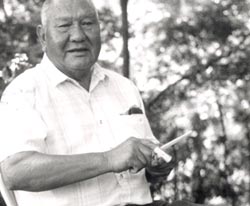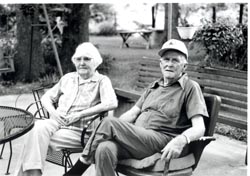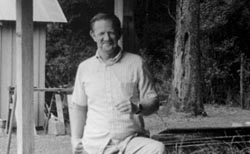Storytelling Traditions in Louisiana
By C. Renée Harvison
Louisianians love a good story. And the sundry stories they swap are as diverse as the ethnic and cultural groups which call the state home. Animal tales, jokes, personal anecdotes, tall tales, legends of ghosts and spirits, buried money, supernatural creatures, heroes and heroines or lawless gangsters, disastrous events or haunted sites-these and countless other kinds of stories are told by Creoles, Cajuns, Native Americans, Anglos, African-Americans, Isleños, Germans, Italians, Spaniards, Czechs, and Vietnamese. Yet despite the variety of types of stories found and of raconteurs who spin them, it is this persistent love of storytelling, the infectious impulse to "tell you a good one," which unifies Louisiana's people and crosses all of its cultural and ethnic boundaries.
Popular among many of the state's groups are folktales— traditional fictional narratives which are intended for entertainment but frequently illustrate some truism or moral. Louisiana's folktales include many of the tale types found universally, but with notable cultural modifications. The folktales of French Louisiana are similar to tales found in parts of Canada, Missouri, and the Antilles, and reflect a close relationship to the narrative lore of France. The folktales of the piney hills of North Louisiana—populated primarily by English-speaking people—are more illustrative of Anglo narrative lore.
Louisiana's narrative maze becomes even more intricate when the state's smaller enclaves are considered. In the parish of St. Bernard, folktales of Spanish origin are told by Isleños, whose ancestors emigrated from the Canary Islands. In Natchitoches Parish, oral traditions of the Spanish Lake community are Hispanic and Native American in origin. The communities of Kolin and Libuse in Rapides Parish maintain a Czechoslovakian oral tradition.
Folktales are an integral part of Louisiana's heritage. They reflect a fascinating array of cultures which have modified each other, yet they retain a flavor of the individual teller's background. For instance, the main characters of animal tales usually conform to stock types. These types are often ancient in origin and may be either tamed or wild animals that speak, think, and act like ordinary people. The cunning wolf or rabbit, and the stupid wolf, alligator or bear, are common examples.
Even though the animals found in a South Louisiana Creole folktale belong to these stock types, in the local versions they become the dull-witted Bouki (whose name originates from an African word meaning hyena) and his clever companion, Lapin (Rabbit). Similar characters found in the African American tradition are Br'er Rabbit and Tarbaby. Br'er Rabbit's more contemporary trickster counterparts, Shine (who is a man, not an animal) and the Signifying Monkey, appear in long epic poems called "toasts."
Native American Bel Abbey, a Koasati (or Coushatta) from Elton, tells his version of the race between the turtle and the rabbit. Although the moralistic ending is familiar, the listener also learns why the turtle has a spotted back—when the rabbit discovered that the turtle had won the race, the rabbit got mad. Bel explains: "He got a stick like this and start beating on top of the back of the shell. Break him all up. That's what you see there now, that's [why] the marks in there. On the back, the little skulls in there on the back."
The final lesson in these tales is generally the same regardless of ethnic or regional background: a sharp wit and resourcefulness pay off, while stupidity and greediness go unrewarded.
Adventure stories are still a strong oral tradition in the South. These often revolve around an adolescent hero or heroine who may be a commoner or an underdog but overcomes a series of obstacles through bravery, intelligence, and resourcefulness. Favorite heroes and heroines among Louisiana's French-speaking inhabitants are 'Tit Jean (Little John), Petit Poucet (Tom Thumb), and Snow Bella.
In addition to adventure stories, cumulative tales (or "chains") have existed throughout the centuries and are still heard on occasion in Louisiana. For example, "Minette et ses Roulettes" ("Minette and His Rollers") is a French Louisiana variation of the Breton tale, "Little John and Jacky." Another commonly told cumulative tale is "The Old Woman and Her Pig."
Although the tall tale (also known as whoppers or windies) is often associated with Texas or the frontier, it maintains a strong popularity in Louisiana, particularly among the state's many sportsmen who boast of outwitting deer, squirrels, ducks, raccoons or alligators. The wit of these tales comes from detailed, exaggerated fiction told in the guise of a truthful story. A tall tale's success does not hinge only upon exaggeration and ludicrous imagery. It depends upon the audience allowing itself to be lied to, and more importantly, upon the teller's ability to keep a straight face. Many of the most comical tall tales are told in first person, as if experienced by the teller himself.
Tall tales also become more appealing through embellishment: smart animals are made smarter, bad weather is made worse, mean people are made meaner. Lonnie Gray, a lifetime resident of the North Louisiana town of Bernice and tall tale teller extraordinaire, tells one about a smart bear who was stealing corn from a fellow's field. When the fellow followed the bear, he discovered "a big hollow stump there and this old bear had caught one of them old pine rootin' hogs. He'd put him in that hollow stump! He was toting corn down there and feeding him to get him fat enough to eat!" Lonnie also includes in his repertoire the story of the fish that was so big, when he blinked he sunk a boat full of fishermen. And there is the mountaineer who was so mean, when he was baptized in the river all of the fish within a hundred yards were killed. Hugh McGee, also from Bernice, tells about the hunter who was so ugly, all he had to do was look at a squirrel to scare him to death. The clever charm of tales such as these cannot truly be appreciated in print. It comes from the teller's talent in a verbal art form and from a second nature for stretching the truth.
Like tall tales, the appeal of jokes and humorous anecdotes depends greatly on the skill of the teller. Two common dupe characters found in Louisiana jokes and anecdotes are politicians and clergymen; this is hardly surprising in a state where both religion and politics are taken seriously and with due reverence.
However, the fool in anticlerical jokes is not always the clergyman; sometimes it is a member of the congregation. In this story told by Harry Methvin, lifetime resident of Hargrove Settlement, the preacher's rhetorical declaration in the sermon gets a straight but ridiculous reaction from one of his flock:
They had this guy who always fell asleep in church. His preaching couldn't keep the guy awake. He noticed that he dozed off one Sunday night. This guy was sitting there slumped over, he was asleep, he was about to begin snoring, and Brother Winn decided, "I'm gonna teach him a lesson, once and for all. " And he was preaching kind of low in submissive tones, and all of a sudden he said, "Everybody who wants to go to hell, stand up! " And it jarred the man from his sleep and he stood up and he looked around at all the people about him and everything was quiet. And he finally said, "I don't know what we voting on preacher, but I'm glad you and I are together on this!
Another large, complex genre of traditional tales is the legend, which is concerned with unusual events involving ordinary people. Unlike folktales, legends are told as truth, usually have a familiar locale as their setting, and are often told to validate a traditional belief. While the basic, traditional content of a legend remains the same from telling to telling, the structure of the tale is loose and may vary with each account. Often storytellers begin a legend with a validating statement like, "This happened to a friend of a friend" or "I read this in the newspaper."
Like its folktales, Louisiana's legends belong to universal categories such as religious, supernatural, or personal. These widely known stories contain traditional narrative elements but are adapted by the teller to a particular place.
One example found throughout America is the tale of hidden wealth ready to be found by some fortuitous seeker. Louisiana is no exception, and stories of buried money are numerous in the state. But the texts of these stories are localized by including specific references to local places and people. For example, in Winn Parish, the Spanish are said to have buried their gold at a place called Couchee Brake.
Stories are also localized through the vocabulary used by the teller. In South Louisiana, the spirit which leads its victims astray is called the "feu follet," while in similar accounts from North Louisiana it becomes the "will 'o the wisp".
Local legends are closely associated with specific places, incorporating place names, geographic features, local history, or colorful and memorable characters whose feats continue to be recounted. Heroes of local legends include South Louisiana's well-known pirate Jean Lafitte and the lesser-known revolutionary Manuel Flores of the Spanish Lake community in Natchitoches Parish.
Local legends may treat their central characters as either heroes or antiheroes. Scattered narratives, sometimes heroic but more often anti-heroic, circulate about gangsters, for instance. Although the townspeople of Arcadia and Ruston still vividly remember the reign of terror which outlaws Bonnie Parker and Clyde Barrow held over their area, and still tell the stories about it to an interested listener, they would rather let the memories fade. But in the Florida Parishes in southeast Louisiana, accounts of the notorious but good-hearted, Robin-Hood-like train robber, Eugene Bunch, are still freely told almost a hundred years later.
In west-central Louisiana, stories are told about military leaders who were there on maneuvers during World War II. In northeast Louisiana, stories still circulate of Teddy Roosevelt's bear hunt. Throughout all of Louisiana, anecdotes continue to be told of charismatic politicians-such as the Longs and their political dynasty-who have taken on legendary proportions.
A common misperception is that "the folk" and folklore exist only in remote or isolated regions and that both are rapidly disappearing in the modern world. However, from the above swatches of Louisiana's inexhaustible storytelling tradition, it is evident that this tradition is a vital part of the state's personality. Fertile ground for stories may be found along the muddy banks of its backwaters and bayous, in the flat, verdant prairies, from the echoing depths of the piney hills, in our complex cities, or, more simply, in our own homes. Louisiana's storytelling tradition serves as more than a superficial source of entertainment. It teaches values, reflects shared beliefs, and draws people together.
For more information about the publication Swapping Stories: Folktales from Louisiana, click here.





